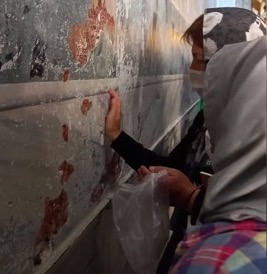
Visitor peeling strips of a painted marble wall at Hagia Sophia and collecting it in a bag., spring 2022.
Marble floor tiles smashed by heavy machinery, visitors peeling paint off its walls and taking chips from its ‘Emperor’s door’: the ongoing damage to Turkey’s most important World Heritage site, Hagia Sophia, is even worse than was predicted when Turkish President Recep Tayyip Erdoğan announced that Hagia Sophia would once again become a mosque in March 2019. Erdoğan has made the 1500-year-old building the symbolic centerpiece of his campaign to depict himself as an Islamic leader like those of the Ottoman conquest. At the same time, neglect, mismanagement and damage by worshipers are causing the World Monument serious, irreparable harm.
“As our ancestors buried Byzantium, let us hope that today, by building our vision for 2053, we also manage to put in the time warp of history the current Byzantines who are plotting against us.”
Turkish President Recep Tayyip Erdoğan, May 2022. (The “current Byzantines” are, of course, the Greeks.)
Hagia Sophia is a UNESCO World Monument and one of the greatest examples of Byzantine architecture. The 6th century cathedral was constructed by the Emperor Justinian I as a Christian basilica and became a centerpiece of Eastern Roman rule in Constantinople. Hagia Sophia was briefly reconsecrated as a Catholic cathedral in the 13th century, then returned to its original role. When Turkish Sultan Mehmet II captured Constantinople in the mid 15th century, he ordered its conversion to a Muslim mosque, and after the fall of the Ottoman empire, modernizing Turkish leader Mustafa Kemal Ataturk converted Hagia Sophia and a number of other ancient cathedrals that had been made into mosques into museums open to all. In the 20th and early 21st centuries, Hagia Sophia was one of the most visited sites and popular museums in Turkey, drawing over three million visitors each year.
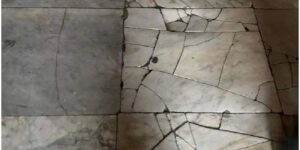
Marble tiles smashed by heavy machinery at Hagia Sophia, June 2022.
Turkish President Recep Tayyip Erdoğan’s recasting of Hagia Sophia as a monument to Islamic conquest and himself in the character of an Ottoman ruler is calculated politics. A son et lumiere lightshow at Hagia Sophia at the close of Istanbul’s celebration of the 569th anniversary of the fall of Byzantine rule featured violent virtual confrontations: giant projections of Mehmet II as a mounted conqueror or with warships and cannons blazing over Hagia Sophia’s dome, scimitar-bearing warriors cutting down Crusader-garbed opponents – and a blaring soundtrack describing Hagia Sophia as the symbol of Turkish sovereignty:
“Istanbul will be praised forever with the name of the Conqueror”… ”[Mehmet II] proceeded to Constantinople without being afraid, with his heart burning for the conquest. Together with his holy army he would either fall dead or become the Conqueror… [Hagia Sophia] is the heart of the world …and the voice of the imam will always be heard.”
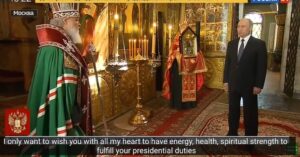
Screenshot of the blessing bestowed upon President Putin of Russia by Russian Patriarch Kirill.
Erdoğan’s cultural war against Turkey’s minority religious populations is calculated to energize his rural political base, but his policy of transforming church-museums into mosques isn’t just a domestic power-play. It is linked to his taking Putin’s part with respect to NATO and Ukraine and Turkey’s active part in raising the profile of Russian Patriarch Kiril. This both appeases Kiril’s close buddy Putin and threatens the U.S.-friendly Ecumenical patriarch, who is traditionally a Greek Orthodox leader from Turkey. Erdoğan has placed legal barriers to a Greek-born leader succeeding to the aging prelate. The Turkish president has also allowed blatant anti-Semitism to flourish among his followers and continues to dispossess Turkey’s shrinking Jewish community of their religious heritage (with the tacit cooperation of the U.S State Department’s Educational and Cultural Affairs section). He has authorized the rewriting of the history of Armenian and Kurdish monuments and directed overall heritage policy towards emphasizing and preserving the Muslim past.
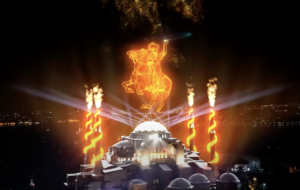
Son et lumière performance at Hagia Sophia, May 29, 2022.
It requires willful ignorance to see Hagia Sophia simply as the embodiment of an Ottoman victory over a moribund Byzantine empire. Nonetheless, Erdoğan has done all he can without actually destroying the building to erase its most important message: that its 1500 year history is a blending of multiple narratives in which no political regime or absolutist identity lasts forever.
Hagia Sophia stands for history itself – the building encompasses national, regional, global, religious, and cultural significance. Hagia Sophia’s combination of Roman, Byzantine, Seljuk, and Ottoman artistry and its transitions from being in turn an Orthodox, Catholic, and Muslim place of worship are the most fascinating aspects of the building and convey its most powerful message. In its almost 100 years as a museum, Hagia Sophia stood for the ideas that human culture is global and history serves more than national interests.
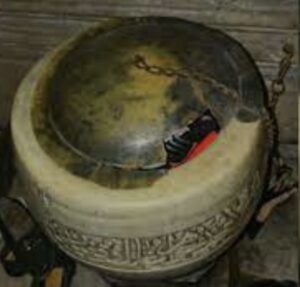
Worshippers’ shoes stuffed into a broken ancient water tank at Hagia Sophia, spring 2022.
Erdoğan’s severing of Hagia Sophia from its protection as a museum has had disastrous physical consequences for the building. By failing to acknowledge the building’s age and fragility, he is allowing Hagia Sophia to be destroyed bit by bit. The General Directorate of Foundations, which now controls Hagia Sophia, appears to have abandoned the crowd control and security precautions put in place when it was a museum, despite the presence of dozens of cameras and formerly well-established security protocols.
Turkish cultural officials, journalists and members of Parliament have all reported serious damage to the building.
In mid-April, Art History Association head Şerif Yaşar first reported that people coming to worship were tearing small pieces off the Emperor’s Gate door (itself a 19th C. restoration by Fossati), and putting them in their mouths.
The General Directorate of Foundations issued a statement on April 21 that there was no lack of security in Hagia Sophia and that the Emperor’s Gate of the Hagia Sophia Mosque had been repaired, saying the damage was due to “normal wear and tear.”
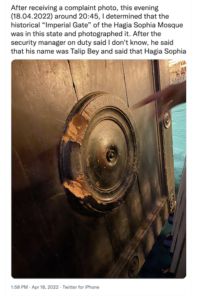
Damage to 19th C. “Emperor’s Gate” door at Hagia Sophia.
Istanbul Metropolitan Municipality Deputy Secretary posted photos from security cameras and descriptions on social media accounts of destruction. Visitors have been photographed stripping sections of paint that imitate marble from Hagia Sophia’s walls and putting pieces in plastic bags to carry them away. Pieces of wood from the door at the Emperor’s Gate have been pulled off and supposedly eaten as they are thought to have restorative or holy power by visitors attending for mosque services. Visitors have also been stuffing shoes into door frames and other odd places in the building, some placing their shoes inside the historic, ancient water tank, whose lid is broken.
In May, Mahir Polat, former head of the Cultural Heritage Department and appointed Deputy Secretary Genera Responsible for Reconstruction, Studies and Projects in 2020, placed photos of similar damage on social media, describing it as “insulting the sanctity and historical value of Hagia Sophia,” and asking, “154 cameras, 69 security and tourism police don’t they see this?”
On June 3, Parliamentary questions were raised over destruction and supposed “protection” of the walls by a “security strip” of rope or plastic forming a barrier a few feet in front of the walls (like a museum barrier but without guards or supervision) by HDP Muş Deputy Gülüştan Kılıç Koçyiğit. He shared images of the destruction and lack of security at Hagia Sophia and asked,
“What is the reason why extensive security measures are not taken in Hagia Sophia, where first its door and then its wall were destroyed?”

Worshippers’ shoes hung on the wall of Hagia Sophia, spring 2022.
The head of the Art History Association, Şerif Yaşar, told Habertürk TV that he was told there were no security recordings kept. Unfortunately, the lack of proper conservation at Hagia Sophia is not unique. Istanbul Deputy Gamze Akkus İlgezdi submitted a Parliamentary question to its committee on UNESCO, stating in his motion:
“There has not been a single statement from the Ministry of Culture and Tourism until this hour. If this is not a historical betrayal, what is? I showed with photographs that historical artifacts were damaged because ‘we are building roads’ in the Topkapı Palace campus. Now this is done to Hagia Sophia. We are faced with a ministry that does not protect our cultural values. When the Ministry of Culture and Tourism did not move a finger, the Art History Association tried to get information on the subject, but it was stated that there was not even a camera recording. I ask; Will the Ministry of Culture and Tourism be held accountable for this attack? Has action been taken for Hagia Sophia? If not, what are you waiting for? To be destroyed?”
Recently, irreparable damage has been done to the marble floors of Hagia Sophia. At the end of June 2022, tour guide Özlem Kabasakal reported to the Cumhuriyet newspaper that a scissor platform brought into Hagia Sophia for heavy cleaning has broken marbles at the entrance and at multiple locations in Hagia Sophia. The heavy tonnage platform for machinery is ordinarily used to scrub flooring in modern buildings. Kabasakal said, “”this historic building has been badly damaged. When Hagia Sophia was a museum, visits were made with great respect. At the moment, its interior looks like a festival.”
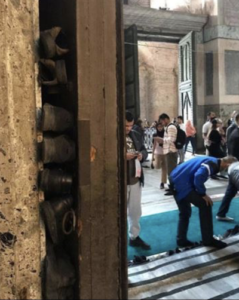
Shoes stuffed into a crack of a Hagia Sophia door by Muslim worshippers.
The use of Hagia Sophia as a soft-power propaganda tool by the Erdoğan government is plain. During the celebrations of the 569th anniversary of the sacking of Byzantium, Turkey’s Ministry of National Defense (MSB) stated flatly that, “Hagia Sophia, which has been used as a mosque for centuries, has been under the protection of the Turkish nation since 1453.” He also pointed to Greece’s past destruction of mosques inside territory it controlled.
It may go too far to say that Erdoğan has encouraged the abuses now perpetrated on Hagia Sofia. Turkey’s less-educated rural population forms much of Erdoğan’s political power base and undoubtedly many have come to worship at Hagia Sophia who never visited it as a museum. But when one of the most important World Monuments is used as an ordinary mosque, and 40,000-45,000 people pass through it relatively unsupervised every day, the result is mistreatment.
Erdoğan is responsible, however, for the failure of the people who now administer Hagia Sophia to protect it. In the last months, under the supervision of the General Directorate for Foundations (supervising religious entitles) Hagia Sophia has been the victim of unpardonable neglect, bureaucratic incompetence, malignant arrogance and the deliberate choice not to utilize the resources that were available to its custodians when it was a museum.

Video of Hagia Sophia performance celebrating 569th anniversary conquest of Constantinople, May 2022.
The Turkish government earlier turned two other ancient Orthodox Christian cathedrals into mosques: the Hagia Sophia of Iznik (Nicaea) was changed from a museum to a mosque in 2011, and the Hagia Sophia in Trabzon was converted in 2013. The conversion of Hagia Sophia, the most important early Byzantine church, was followed quickly by the announcement that Kariye Çamii, on the edge of Istanbul, and the most important example of late Byzantine artistry, would also be converted to a mosque. A source knowledgeable in Byzantine architecture told CPN that Karye Camii has not yet opened as a mosque, but that information on its status is now very difficult for academics to access.
Erdoğan’s focus on religious issues and on blaming outsiders for Turkey problems is seen by some as an attempt to distract its citizens from record 73% inflation in May, collapsing currency and skyrocketing energy costs. Certainly, announcements of mosque conversions and religious campaigns often coincide with election campaigns. But Erdoğan’s goals are long term.

Video of Hagia Sophia performance celebrating 569th anniversary conquest of Constantinople, May 2022.
Erdoğan’s program for Turkish greatness is centered on specific historical dates: 2023, 2053, and 2071. 2023 is the 100th anniversary of the foundation of the Turkish Republic, 2053 is the 600th anniversary of the Turkish conquest of Constantinople and end to eastern Roman power, and 2071 marks 1000 years after the battle of Manzikert when the Byzantines were defeated by the army of Alp Arslan’s Seljuk Turks, enabling the Seljuks to take over much of eastern Anatolia. In 2020, Imam Ali Erbaş, Turkey’s head of the Religious Affairs Directorate (Diyanet) gave the first sermon in Hagia Sophia holding a sword. The imam said that preaching with a sword sends a message about the conversion of Hagia Sophia into a mosque on the one hand and of conquest on the other.
Education officials in Istanbul say that Erdoğan is also using the same revisionist religious goals to manipulate Turkish education policy. On April 15, the President attended the opening of the rebuilt Hagia Sophia Fatih Madrasa next to Hagia Sophia (a madrasah located there in the 19th C. had been torn down in 1924 under Ataturk). Erdoğan’s and other speeches at the opening referenced the creation of museums from
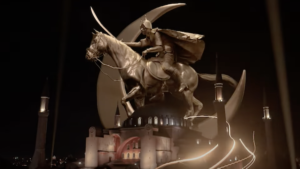
Video of Hagia Sophia performance celebrating 569th anniversary conquest of Constantinople, May 2022.
mosques under Ataturk as a terrible mistake. A speech by education/teaching union head Kadem Özbay criticized the reconstruction and reopening of the madrasa, saying that, “The dervish lodges that surrounded education like a spider’s web in the Ottoman period and were abolished thanks to the Headteacher [a title given Ataturk], today are wearing the mask of [religious] associations and subcontracting education…” a reversion to the bad old days of the pre-revolutionary past.
Click to view the extraordinary video of the May 29, 2022 son et lumière performance at Hagia Sophia.
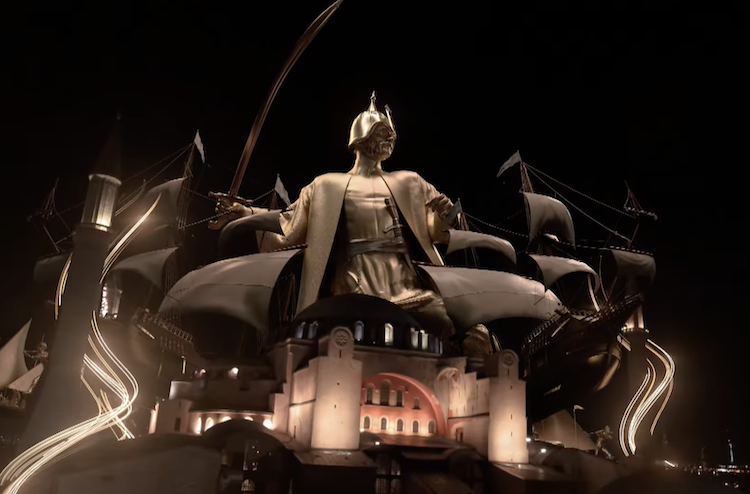 Video of Hagia Sophia performance celebrating 569th anniversary of Mehmet II's conquest of Constantinople, May 2022.
Video of Hagia Sophia performance celebrating 569th anniversary of Mehmet II's conquest of Constantinople, May 2022. 

